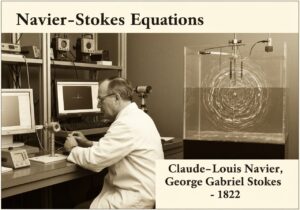The Cauchy 强调 tensor, denoted [latex]\boldsymbol{\sigma}[/latex], is a second-order tensor that completely defines the state of stress at a point inside a material. It relates the traction vector (force per unit area) [latex]\mathbf{T}[/latex] on any surface passing through that point to the surface’s normal vector [latex]\mathbf{n}[/latex] via the linear relationship [latex]\mathbf{T} = \boldsymbol{\sigma} \cdot \mathbf{n}[/latex].
柯西应力张量
- Augustin-Louis Cauchy

The Cauchy stress tensor provides a complete description of the internal forces acting within a deformable body. Imagine an infinitesimal cube of material at a point P. Forces are exerted on each face of this cube by the surrounding material. The stress tensor [latex]\boldsymbol{\sigma}[/latex] is a 3×3 matrix whose components [latex]\sigma_{ij}[/latex] represent the stress on the i-th face in the j-th direction. The diagonal components ([latex]\sigma_{11}, \sigma_{22}, \sigma_{33}[/latex]) are normal stresses, representing pulling (tension) or pushing (compression) perpendicular to the face. The off-diagonal components ([latex]\sigma_{12}, \sigma_{23},[/latex] etc.) are shear stresses, representing forces acting parallel to the face.
A key result, known as Cauchy’s stress theorem, states that knowledge of the stress vectors on three mutually perpendicular planes is sufficient to determine the stress vector on any other plane passing through that point. This is encapsulated in the formula [latex]\mathbf{T}^{(\mathbf{n})} = \boldsymbol{\sigma}^T \mathbf{n}[/latex]. Furthermore, the conservation of angular momentum requires the stress tensor to be symmetric ([latex]\sigma_{ij} = \sigma_{ji}[/latex]), which reduces the number of independent components from nine to six. This tensor is fundamental because it allows engineers to analyze the stress state at any point within an object, regardless of its orientation, and to predict whether the material will yield or fracture under applied loads by comparing the stress state to the material’s strength properties.
类型
中断
使用方法
前体
- 牛顿运动定律
- Euler’s concept of pressure in fluids
- 向量和矩阵(张量)的数学框架
- 库仑的摩擦学和土壤力学研究成果
应用
- 对建筑物、桥梁和飞机进行结构分析以预测故障
- 运用地质力学分析隧道和地基设计中岩石和土壤的应力
- 材料科学,用于了解材料失效机制,如断裂和疲劳
- 用于计算骨骼和组织在负载下的应力的生物力学
专利:
迎接新挑战
机械工程师、项目、工艺工程师或研发经理
可在短时间内接受新的挑战。
通过 LinkedIn 联系我
塑料金属电子集成、成本设计、GMP、人体工程学、中高容量设备和耗材、精益制造、受监管行业、CE 和 FDA、CAD、Solidworks、精益西格玛黑带、医疗 ISO 13485
历史背景
柯西应力张量
(如果日期不详或不相关,例如 "流体力学",则对其显著出现的时间作了四舍五入的估计)。
相关发明、创新和技术原理























